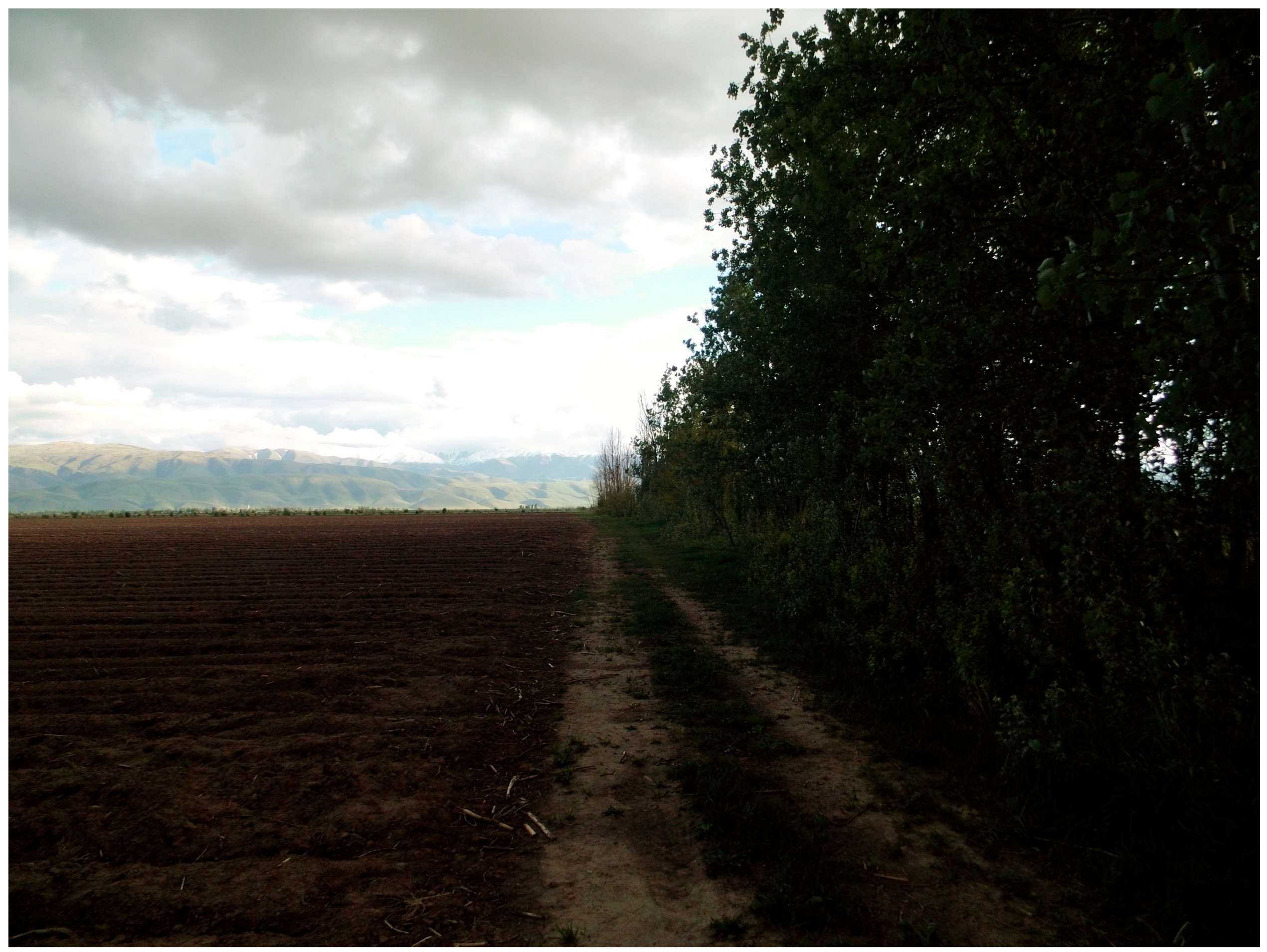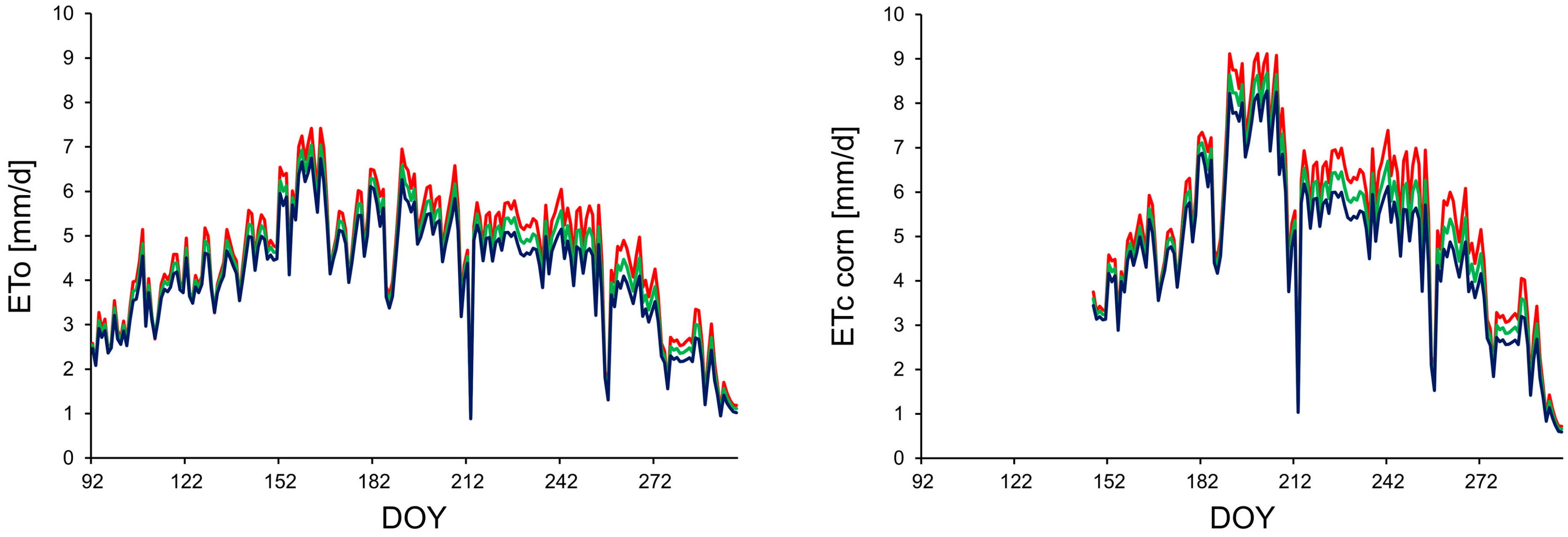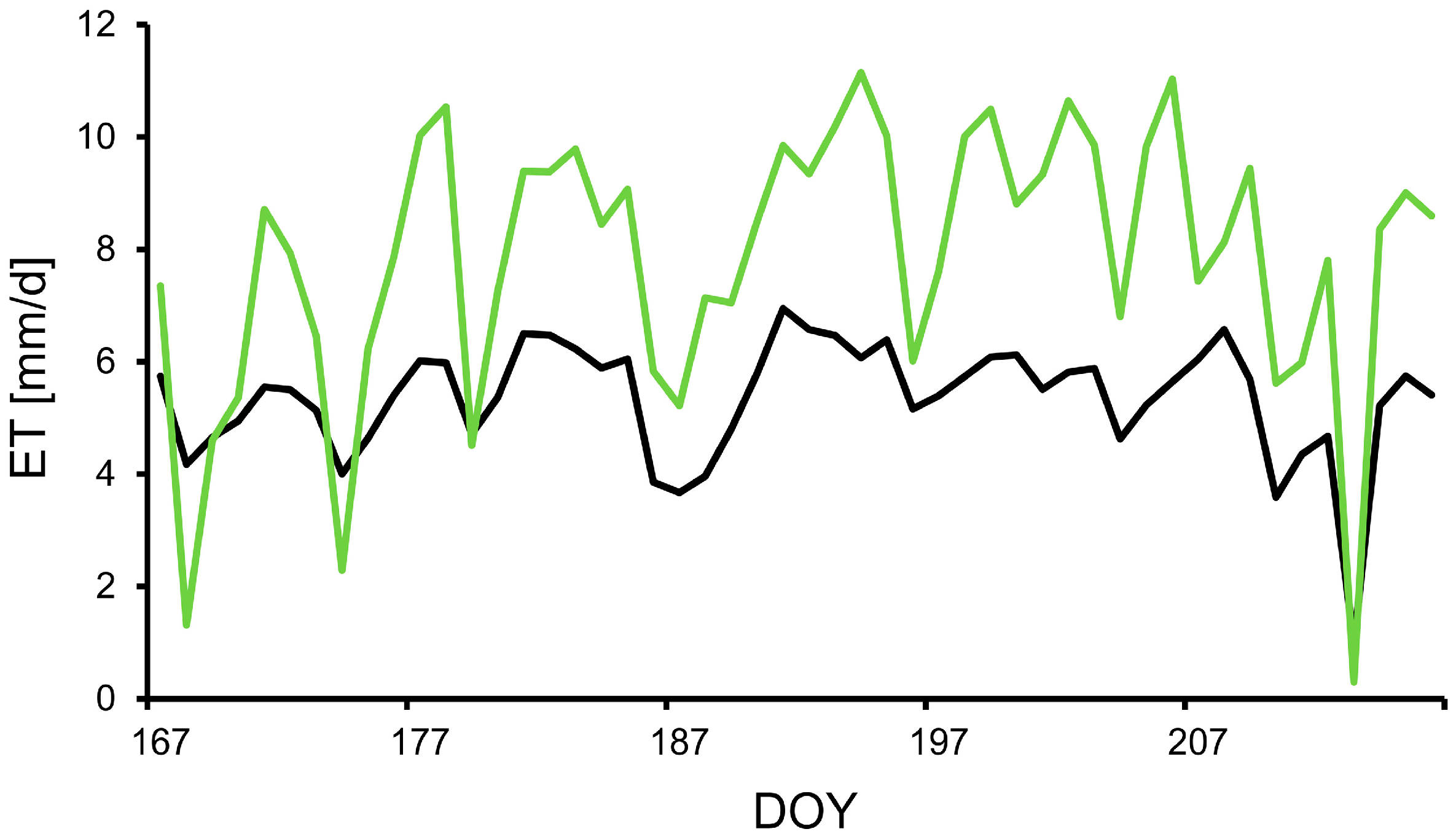Tree Shelterbelts as an Element to Improve Water Resource Management in Central Asia
Abstract
:1. Introduction
2. Materials and Methods
2.1. Study Region
2.2. Water Consumption of Shelterbelt System vs. Non Shelterbelt System
- u—sap flow density (mL cm−2 min−1)
- dT—temperature difference between the two needles of one needle pair
- dTmax—maximal dT, i.e., dT at zero sap flow
- ϕ—sap flow (mL min−1)
- u—sap flow density (mL cm−2 min−1)
- SA—sap wood area (cm2)
3. Results
4. Discussion
Acknowledgments
Author Contributions
Conflicts of Interest
References
- MEA (Millennium Ecosystem Assessment). Ecosystems and Human Well-being: Synthesis; Island Press: Washington, DC, USA, 2005. [Google Scholar]
- Karthe, D. Environmental Changes in Central and East Asian Drylands and their Effects on Large Central and East Asian Lakes and their Effects on Major River-Lake Systems. Quat. Int. 2017. [Google Scholar] [CrossRef]
- UNEP (United Nations Environment Programme). 2004. Available online: http://www.grid.unep.ch/activities/sustainable/balkhash/ (accessed on 20 November 2016).
- Micklin, P. The future Aral Sea: Hope and despair. Environ. Earth Sci. 2016, 75, 1–15. [Google Scholar] [CrossRef]
- CACILM (Central Asian Countries Initiative for Land Management); ADB (Asian Development Bank). Central Asia Atlas of Natural Resources; CACILM and ADB: Manila, Philippines, 2010; Available online: http://www.adb.org/sites/default/files/publication/27508/central-asia-atlas.pdf (accessed on 2 July 2015).
- Unger-Shayesteh, K.; Vorogushyn, S.; Farinotti, D.; Gafurov, A.; Duethmann, D.; Mandychev, A.; Merz, B. What do we know about past changes in the water cycle of Central Asian headwaters? A review. Glob. Planet. Chang. 2013, 110, 4–25. [Google Scholar] [CrossRef]
- Feike, T.; Mamitimin, Y.; Li, L.; Abdusalih, N.; Doluschitz, R. Development of agricultural land and water use and its driving forces in the Aksu-Tarim Basin, P.R. China. Environ. Earth Sci. 2015, 73, 517–531. [Google Scholar] [CrossRef]
- Rumbaur, C.; Thevs, N.; Disse, M.; Ahlheim, M.; Brieden, A.; Cyffka, B.; Duettmann, D.; Feike, T.; Frör, O.; Gärtner, P.; et al. Sustainable management of river oases along the Tarim River (SuMaRiO) in Northwest China under conditions of climate change. Earth Syst. Dyn. 2015, 6, 83e107. [Google Scholar] [CrossRef]
- Albenskii, A.V.; Kalashnikov, A.F.; Ozolin, G.P.; Nikitin, P.L.; Surmach, G.P.; Kulik, N.F.; Senkevich, A.A.; Kasyanov, F.M.; Pavlovskii, E.S.; Roslyakov, N.V. Agroforestry Melioration; Lesnaya Promyshlennost: Moscow, Russia, 1972. [Google Scholar]
- Vasilyev, M.E. Melioration through Forests and Harvest; Kainar: Almaty, Kazakhstan, 1980. [Google Scholar]
- Alemu, M.M. Ecological Benefits of Trees as Windbreaks and Shelterbelts. Int. J. Ecosyst. 2016, 6, 10–13. [Google Scholar] [CrossRef]
- Perry, C.H.; Woodall, C.W.; Liknes, G.C.; Schoeneberger, M.M. Filling the gap: improving estimates of working tree resources in agricultural landscapes. Agrofor. Syst. 2009, 75, 91–101. [Google Scholar] [CrossRef]
- Stepanov, A.M. Agroforestry Melioration in Irrigated Lands; Agropromizdat: Moscow, Russia, 1987. [Google Scholar]
- Dokuchaev Scientific Research Institute of Agriculture. Agroforestry Melioration of Vegetable Cultures and Potato; Voronesh Publishing House: Voronesh, Russia, 1961. [Google Scholar]
- Susa, N.I. Agroforestry Melioration; Governmental Publishing House for Agriculture: Moscow, Russia, 1959. [Google Scholar]
- Kainar. Agroforestry in Kazakhstan; Kainar: Almaty, Kazakhstan, 1983. [Google Scholar]
- Bulychev, A.S.; Onishenko, L.P. Use and Effectiveness of Tree Shelterbelts in Chui Valley; Advisory Report of the Forestry Committee to the Ministries of the Kyrgyz SSR; Publishing House “Kyrgyzstan”: Frunze, Kyrgyzstan, 1979. [Google Scholar]
- Allen, R.G.; Pereira, L.S.; Raes, D.; Smith, M. Crop Evapotranspiration—Guidelines for Computing Crop Water Requirements; FAO Irrigation and Drainage Paper 56; FAO: Rome, Italy, 1998. [Google Scholar]
- Granier, A. Evaluation of transpiration of in a Douglas fir stand by means of sap flow measurements. Tree Physiol. 1987, 3, 309–320. [Google Scholar] [CrossRef] [PubMed]
- Lubczynski, M.W.; Chavarro-Rincon, D.; Roy, J. Novel, cyclic heat dissipation method for the correction of natural temperature gradients in sap flow measurements. Part 1. Theory and application. Tree Physiol. 2012, 32, 894–912. [Google Scholar] [CrossRef] [PubMed]
- Chang, X.X.; Zhao, W.Z.; Zhang, Z.H.; Su, Y.Z. Sap flow and tree conductance of shelter-belt in arid region of China. Agric. For. Meteorol. 2006, 138, 132–141. [Google Scholar] [CrossRef]
- Howell, T.A.; Tolk, J.A.; Schneider, A.D.; Evett, S.R. Evapotranspiration, yield, and water use efficiency of corn hybrids differing in maturity. Agron. J. 1998, 90, 3–9. [Google Scholar] [CrossRef]
- Thevs, N.; Nurtazin, S.; Beckmann, V.; Salmurzauly, R.; Akimalieva, A. Water consumption of agriculture and natural ecosystems along the Ili River in China and Kazakhstan. Water 2017, 9, 207. [Google Scholar] [CrossRef]
- Hochmuth, H.; Thevs, N.; He, P. Water allocation and water consumption of irrigation agriculture and natural vegetation in the Heihe River watershed, NW China. Environ. Earth Sci. 2015, 73, 5269–5279. [Google Scholar] [CrossRef]





| Climatic Feature | Tokmok Data |
|---|---|
| Geographical position | 42.51° N, 75.18° E |
| Elevation [m a.s.l.] | 824 |
| Annual average temperature [°C] | 11.6 |
| January average temperature [°C] | −2.7 |
| July average temperature [°C] | 24.8 |
| Annual precipitation [mm] | 522 |
| Average wind speed in 10 m height [m/s] | 1.2 |
| No. of Sensor Tree | Diameter at Breast Height (DBH) (cm) | Tree Height (m) | Age (a) | Average Xylem Thickness (cm) | Sapwood Area (cm2) |
|---|---|---|---|---|---|
| 1 | 42.6 | 16 | 27 | 8.07 | 875 |
| 2 | 19.2 | 16.4 | 14 | 3.8 | 183 |
| 3 | 31.5 | 15.2 | 19 | 7.3 | 554 |
| Month | Temperature (°C) | Relative Air Humidity (%) | Wind Speed (m/s) | ETo (mm/d) |
|---|---|---|---|---|
| 4 | 12.7 | 60 | 2.0 | 3.5 |
| 5 | 16.5 | 55 | 2.0 | 4.6 |
| 6 | 21.3 | 49 | 1.9 | 5.9 |
| 7 | 22.0 | 49 | 2.0 | 5.3 |
| 8 | 21.2 | 43 | 2.2 | 5.4 |
| 9 | 19.9 | 40 | 2.3 | 4.4 |
| 10 | 8.7 | 56 | 2.3 | 2.2 |
| ETo and Crops | ETo and ETc under Open Field Conditions | ETO and ETc under Shelterbelt Assumptions | Difference of ETo and ETc between Open Field and Assumption | ||
|---|---|---|---|---|---|
| I | II | I | II | ||
| ET (mm) | |||||
| ETo | 938.9 | 893.2 | 847.3 | 45.7 | 91.6 |
| Wheat | 611.2 | 586.2 | 561 | 25 | 50.2 |
| Corn | 815.1 | 764 | 717.1 | 51.1 | 98 |
| Potato | 660.7 | 632.2 | 603.6 | 28.5 | 57.1 |
| Barley | 584.7 | 561.4 | 537.2 | 23.3 | 47.5 |
| Fruit trees (pear) | 1093.3 | 1025.3 | 962.4 | 68 | 130.9 |
| ET for 4 ha field (m3) | |||||
| Eto | 37,555 | 35,272 | 33,890 | 1828 | 3664 |
| Wheat | 24,446 | 23,448 | 22,439 | 999 | 2007 |
| Corn | 32,604 | 30,560 | 28,683 | 2044 | 3921 |
| Potato | 26,427 | 25,288 | 24,145 | 1139 | 2238 |
| Barley | 23,388 | 22,456 | 21,486 | 931 | 1901 |
| Fruit trees (pear) | 43,732 | 41,012 | 38,494 | 2720 | 5237 |
| ET for 25 ha field (m3) | |||||
| Eto | 234,717 | 223,291 | 211,816 | 11,426 | 22,901 |
| Wheat | 152,790 | 146,547 | 140,246 | 6243 | 12,544 |
| Corn | 203,778 | 191,001 | 179,269 | 12,777 | 24,509 |
| Potato | 165,172 | 158,052 | 150,906 | 7120 | 14,266 |
| Barley | 146,172 | 140,353 | 134,289 | 5819 | 11,883 |
| Fruit trees (pear) | 273,324 | 256,325 | 240,590 | 16,999 | 32,734 |
| Crop | Water Consumption of | Difference between | |||
|---|---|---|---|---|---|
| Open Field | Shelterbelt System Including Trees, Assumptions | Shelterbelt System and Open Field, Assumptions | |||
| I | II | I | II | ||
| Water consumption for 4 ha field (m3) | |||||
| ETo | 37,555 | 40,460 | 39,078 | 2905 | 1523 |
| Wheat | 24,446 | 28,636 | 27,627 | 4190 | 3181 |
| Corn | 32,604 | 35,748 | 33,871 | 3144 | 1267 |
| Potato | 26,427 | 30,476 | 29,333 | 4049 | 2906 |
| Barley | 23,388 | 27,644 | 26,674 | 4256 | 3286 |
| Fruit trees (pear) | 43,732 | 46,200 | 43,682 | 2468 | −50 |
| Water consumption for 25 ha field (m3) | |||||
| ETo | 234,717 | 236,261 | 224,786 | 1544 | −9931 |
| Wheat | 152,790 | 159,517 | 153,216 | 6727 | 426 |
| Corn | 203,778 | 203,971 | 192,239 | 193 | −11,539 |
| Potato | 165,172 | 171,022 | 163,879 | 5850 | −1293 |
| Barley | 146,172 | 153,323 | 147,259 | 7151 | 1087 |
| Fruit trees (pear) | 273,324 | 269,295 | 253,560 | −4029 | −19,764 |
© 2017 by the authors. Licensee MDPI, Basel, Switzerland. This article is an open access article distributed under the terms and conditions of the Creative Commons Attribution (CC BY) license (http://creativecommons.org/licenses/by/4.0/).
Share and Cite
Thevs, N.; Strenge, E.; Aliev, K.; Eraaliev, M.; Lang, P.; Baibagysov, A.; Xu, J. Tree Shelterbelts as an Element to Improve Water Resource Management in Central Asia. Water 2017, 9, 842. https://doi.org/10.3390/w9110842
Thevs N, Strenge E, Aliev K, Eraaliev M, Lang P, Baibagysov A, Xu J. Tree Shelterbelts as an Element to Improve Water Resource Management in Central Asia. Water. 2017; 9(11):842. https://doi.org/10.3390/w9110842
Chicago/Turabian StyleThevs, Niels, Eva Strenge, Kumar Aliev, Maksat Eraaliev, Petra Lang, Azim Baibagysov, and Jianchu Xu. 2017. "Tree Shelterbelts as an Element to Improve Water Resource Management in Central Asia" Water 9, no. 11: 842. https://doi.org/10.3390/w9110842




